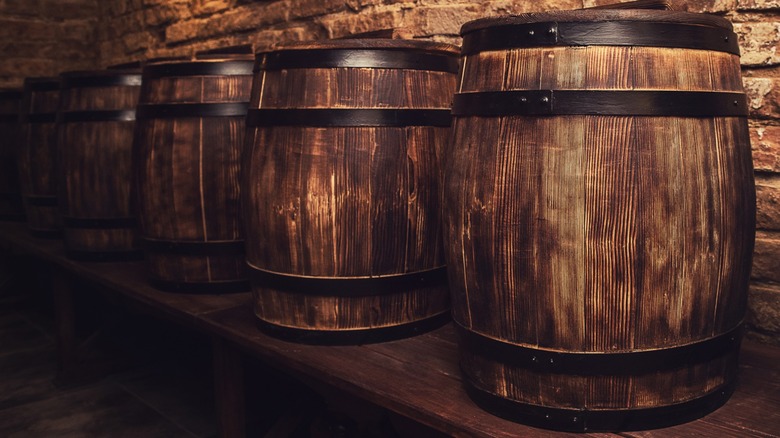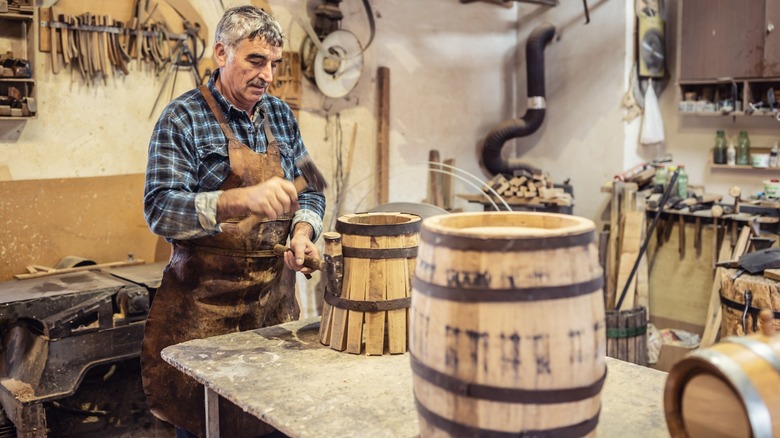Whiskey Barrels Get Reused Often, Just Never For Bourbon
Wooden barrels carry tales galore, spanning decades of baby trees reaching maturity before woodworkers and coopers craft the wood into rounded barrels for fermenting wine, whiskey, beer, and cider. Even after cradling carefully distilled liquids for years as they age to perfection, the barrels often get second, third, or more lives through reuse or repurposing. It's quite common for whiskey barrels to be recycled throughout the alcoholic beverage industry, either used for future company distillations or sold to other distillers, both domestically and internationally. However, there's a glaring exception to this practice.
In the United States, the U.S. Alcohol and Tobacco Tax and Trade Bureau (TTB) requires that bourbon barrels be new and employed only a single time for making bourbon whiskey. These barrels must also be made of charred oak, which imparts distinctive characteristics informing the inimitable flavor, aroma, and earthy amber coloration of the American spirit. But what's to be done with all those single-use bourbon barrels after they give their essence to the process of nurturing whiskey royalty?
They don't get a second shot at making bourbon, but their useful lives are far from over. Instead, the oak barrels become coveted reusable components in the wider world of distilling, either rolling down the road to purveyors of other American spirits, traveling to neighboring Mexico or Canada, or sailing overseas to Scotland, Ireland, or the Caribbean. It's easy to imagine that reusing bourbon barrels is merely a matter of convenience or cost savings. But there's a lot more to the practice than meets the eye — or tongue.
Why used bourbon barrels are a prized commodity
Since bourbon whiskey and its accompanying rules are so narrowly defined, the barrels holding the liquids during fermentation absorb very specific flavors, which are still largely present since the barrels have only been used once. The U.S. TTB strictly regulates how bourbon is barreled. It also requires that the mash bill of any whiskey calling itself a bourbon be comprised of at least 51% corn, with many reaching up to 80%. This infuses the liquid with an element of natural sweetness. Other grains in the mash bill also add spicy or smoky notes to bourbon's flavor.
Consequently, the used American oak barrels carry those flavors into subsequent spirit iterations. Mash bill flavors, combined with the sweet vanilla, honey, and rich caramel notes of the charred oak barrels used in bourbon-making, make for nuanced whiskeys emerging from ex-bourbon barrels, including a high percentage of those made in Scotland. Previously used bourbon barrels also work their earthy magic in the making of all kinds of other spirits, including rum, sherry, tequila, and gin, as well as in wines, ciders, porter beers, and more.
Many food products, such as honey, hot sauces, syrups, and soy sauces, also tout hints of bourbon with monikers such as "bourbon barrel-aged." An authentic way to get that flavor infusion is to let the liquids rest in used oak bourbon barrels, some for up to a year. Outside of the culinary universe, you'll likely see oak bourbon barrels repurposed for use as tables, chairs, rain catchers, home bars, bookshelves, propane grill barrels, and various single-stave home décor items.

